How often do we think about the natural world and wonder what we can do to protect it? With so many environmental challenges facing our planet, the question, “How can I support conservation efforts globally?” has never been more pertinent. The good news is that there are multiple ways we can contribute to global conservation initiatives, making a lasting impact on wildlife, ecosystems, and our shared natural heritage.

Understanding Global Conservation
Before we dive into the many ways we can help, let’s first understand what global conservation entails. Conservation efforts aim to preserve and protect biodiversity, ecosystems, and natural resources. This broad field includes everything from wildlife protection and habitat restoration to combating climate change and promoting sustainable practices.
The Importance of Biodiversity
Biodiversity refers to the variety of life on Earth, encompassing all species of plants, animals, fungi, and microorganisms. High biodiversity provides numerous ecosystem services, such as pollination, climate regulation, and water purification. Unfortunately, biodiversity is rapidly declining due to human activities.
Why Biodiversity Matters
Biodiversity is essential for ecosystem stability and resilience. Diverse ecosystems are better equipped to withstand environmental changes and disruptions. Think of biodiversity as the Earth’s safety net—it bolsters ecosystem productivity and ensures the sustainability of life-supporting resources.
Types of Conservation Efforts
Understanding the various types of conservation efforts helps us identify where we can contribute most effectively. Here are some of the major categories:
Wildlife Conservation
Wildlife conservation focuses on protecting species from extinction and maintaining healthy populations. This can include measures such as habitat protection, breeding programs, and anti-poaching efforts.
Habitat Preservation
Preserving habitats involves safeguarding areas where wildlife live. This can include national parks, nature reserves, and marine protected areas. Effective habitat preservation requires legal protection, active management, and community involvement.
Climate Action
Climate change poses a significant threat to biodiversity and habitats. Reducing greenhouse gas emissions, promoting renewable energy, and supporting climate adaptation strategies are critical parts of conservation.
Sustainable Practices
Promoting sustainable agricultural, forestry, and fishing practices helps reduce environmental degradation. Supporting sustainable products and reducing our ecological footprint can make a big difference.
Pollution Reduction
Reducing pollution—from plastics to industrial waste—is crucial for maintaining healthy ecosystems. Organizing clean-up campaigns, advocating for stricter regulations, and minimizing personal waste are essential actions.
How We Can Support Conservation Efforts Globally
There are many ways we can get involved in global conservation efforts. Here’s a breakdown of practical steps we can take:
Educate Ourselves and Others
Knowledge is power. The more we understand about conservation and the issues at hand, the better equipped we are to take meaningful action. Research different conservation topics, attend workshops, and follow reputable sources to stay informed. Share what you learn with friends, family, and social media networks to raise awareness.
Support Conservation Organizations
There are countless organizations dedicated to various conservation efforts worldwide. By donating, volunteering, or simply endorsing their missions, we can amplify their impact. Here’s a table highlighting some reputable organizations across different conservation areas:
| Organization | Focus Area | How to Support |
|---|---|---|
| WWF | Wildlife | Donations, adoptions, volunteering |
| The Nature Conservancy | Habitat | Donations, memberships, advocacy |
| 350.org | Climate Action | Donations, activism, events |
| Rainforest Alliance | Sustainable Practices | Buying certified products, donations |
| Ocean Conservancy | Marine Life | Donations, beach clean-ups, advocacy |
Make Sustainable Choices
Our everyday choices can reflect our commitment to conservation. Here are some actions we can take:
- Reduce, Reuse, Recycle: Minimize waste by following these principles. Bring reusable bags and containers, recycle properly, and buy products with minimal packaging.
- Support Sustainable Products: Purchase goods that are certified sustainable, such as Fair Trade, Rainforest Alliance, or MSC-certified seafood.
- Conserve Water and Energy: Simple actions like turning off lights, reducing water usage, and opting for energy-efficient appliances can have a big impact.
Participate in Citizen Science
Citizen science involves public participation in scientific research. This can range from tracking wildlife sightings to collecting water samples. Such projects often rely on community involvement to gather large amounts of data. Websites like iNaturalist and eBird allow us to contribute to global biodiversity databases, aiding conservationists in their work.
Advocate for Policy Change
Government policies play a crucial role in conservation efforts. By advocating for stronger environmental protections, we can help shape a sustainable future. Write letters to policymakers, support environmentally-friendly legislation, and participate in public hearings.
Reduce Carbon Footprint
Climate change is a major driver of biodiversity loss. Reducing our carbon footprint can lessen its impact. Some ways to achieve this include:
- Using Public Transportation: Relying less on personal vehicles reduces emissions.
- Adopting a Plant-Based Diet: Livestock production is a significant source of greenhouse gases.
- Supporting Renewable Energy: Consider installing solar panels or choosing green energy plans if available.
Engage in Local Conservation Efforts
Supporting local conservation initiatives can have a global impact. Join local environmental groups, participate in clean-up events, and engage in community conservation projects. Such efforts often provide immediate, tangible benefits.

Understanding the Challenges
While there are many ways to support conservation, it’s also important to understand the challenges faced. These include:
Limited Funding
Many conservation organizations operate on tight budgets. Securing consistent funding is one of their biggest hurdles. By donating and raising awareness about funding needs, we can help alleviate this challenge.
Political and Economic Pressures
Conservation often conflicts with economic development goals. Balancing these interests requires thoughtful policy-making and broad public support. Advocacy and education play crucial roles in making conservation a priority.
Cultural Barriers
Cultural attitudes towards wildlife and natural resources vary globally. Conservation strategies that work in one region may not be effective in another. Understanding and respecting local cultures while promoting conservation is essential.
The Power of Collective Action
No single person can solve the world’s conservation issues, but collective action can drive significant change. When we join forces with others, our efforts are amplified and more likely to succeed.
Community Involvement
Community-based conservation involves local communities in the planning and implementation of conservation projects. This approach ensures that conservation strategies are culturally appropriate and sustainable in the long term. Examples include community-managed forests and locally-led wildlife monitoring programs.
Global Campaigns
Participating in global campaigns, such as Earth Hour or World Environment Day, helps raise awareness and mobilizes action. These campaigns offer opportunities to join millions worldwide in taking steps toward a more sustainable future.
Strengthening Environmental Education
Educating younger generations about the importance of conservation instills values of stewardship and respect for the natural world. Schools, museums, and nature centers can all play a role in this educational process.

Inspiring Stories of Conservation Success
Hearing stories of successful conservation efforts can be incredibly motivating. Here are a few examples:
The Recovery of the Bald Eagle
Once on the brink of extinction, the bald eagle population in the United States has rebounded dramatically thanks to legal protection, habitat restoration, and banning harmful pesticides like DDT.
Madagascar’s Reforestation Efforts
In Madagascar, reforestation projects have resulted in the planting of millions of trees, helping to restore habitats for unique species like lemurs while providing local communities with sustainable resources.
Palau’s Marine Sanctuary
Palau, a Pacific island nation, established one of the world’s largest marine sanctuaries, protecting 80% of its maritime territory from fishing and extractive activities. This action helps preserve marine biodiversity and sustain local fisheries.
Actions We Can Take From Home
Even from the comfort of our home, we can contribute to global conservation efforts. Here are some simple yet effective actions:
Plant a Wildlife-Friendly Garden
Creating a garden that supports local wildlife can have good environmental benefits. Plant native species, create habitats for insects and birds, and avoid using pesticides.
Reduce Plastic Use
Minimize single-use plastics by using alternatives like reusable bottles, bags, and straws. Participate in or organize plastic clean-up events.
Participate in Eco-Friendly Programs
Many companies and communities offer programs aimed at reducing environmental impact. These might include energy rebate programs, composting initiatives, or carpooling networks.
Support Eco-Conscious Businesses
Choose to buy from businesses that prioritize sustainability and ethical practices. Research companies’ environmental policies and support those committed to positive change.
Engage in Digital Activism
Use social media and other online platforms to spread awareness about conservation issues. Signing petitions, sharing educational content, and participating in virtual campaigns are all ways to make an impact from home.

The Role of Technology in Conservation
Modern technology offers unprecedented tools for conservation. From satellite monitoring to data analytics, innovation plays a pivotal role in advancing conservation efforts.
Remote Sensing and GIS
Remote sensing and geographic information systems (GIS) help monitor land use changes, deforestation, and habitat loss. These technologies assist in tracking environmental changes over time and inform conservation strategies.
Wildlife Tracking and Monitoring
GPS collars and drones enable researchers to track animal movements and monitor populations with minimal disruption. This data helps in developing effective conservation plans and understanding species’ behavior.
Citizen Science Apps
Applications like iNaturalist and eBird allow the public to contribute to scientific research by recording wildlife observations. This influx of data is invaluable for biodiversity studies and conservation planning.
Emotional and Psychological Benefits of Conservation Involvement
Engaging in conservation activities not only helps the environment but also offers emotional and psychological benefits. Connecting with nature can reduce stress, improve mental health, and foster a sense of purpose and fulfillment.
Nature Therapy
Spending time in nature has proven therapeutic effects. Activities like hiking, bird-watching, or simply walking in a local park can enhance well-being and promote a deeper connection to the natural world.
Volunteering and Community Building
Volunteering for conservation projects can build a sense of community and foster meaningful relationships. Working towards a common goal creates bonds and provides a sense of belonging.

Looking to the Future
As we look to the future, it’s critical to remain hopeful and proactive. Every effort counts, and collectively, our contributions make a significant difference. We must continue to educate ourselves, support conservation initiatives, make sustainable choices, and inspire others to join us in protecting our planet.
Encourage the Next Generation
Inspiring the next generation to take up the mantle of conservation is crucial for long-term success. Encourage young people to learn about the environment, participate in conservation activities, and pursue careers in related fields.
Adapt and Innovate
The challenges facing global conservation are ever-evolving, requiring adaptability and innovation. By staying informed and open to new ideas, we can effectively address emerging issues and continue making progress.
Conclusion
Supporting global conservation efforts is an ongoing journey that requires dedication, awareness, and collective action. From educating ourselves and advocating for policy changes to participating in local initiatives and reducing our carbon footprint, there are myriad ways we can contribute. Together, we can ensure a healthy, thriving planet for future generations. So, let’s take the first step and commit to making a positive impact, knowing that every effort, no matter how small, brings us closer to a sustainable future.



